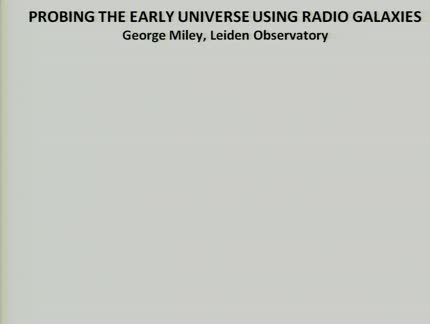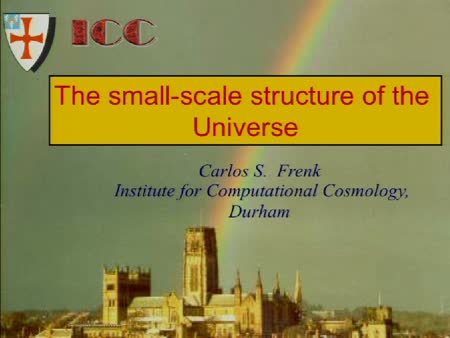Found 93 talks archived in Cosmology

Abstract
The Atacama Cosmology Telescope (ACT) has been observing the southern sky in the millimeter range with an angular resolution at the arc-minute level. An analysis of 228 square degrees observed at 148 GHz along a stripe centered at declination -53 degrees reveals the presence of the Silk damping tail in the temperature angular power spectrum of the Cosmic Microwave Background (CMB). This decaying tail becomes truncated by a rising spectrum at scales corresponding to few arcmins (l ~ 3000) whose origin is compatible with a unclustered population of unresolved point sources and some residual anisotropy due to Compton scattering of CMB photons off free electrons (the Sunyaev-Zel'dovich effect). Comparisons with other observations and constraints on different components giving rise to this secondary spectrum are discussed.
Abstract
Luminous high-redshift radio galaxies (HzRGs) are associated with the most massive known galaxies in the early Universe. These galaxies have the properties expected of the progenitors of dominant galaxies in rich clusters.
I shall describe the properties of HzRGs and demonstrate how they can be used to study the formation and evolution of galaxies and clusters. I shall also show how LOFAR, the new European radio telescope, can be used to extend these probes into the epoch of reionisation.

Abstract
In this work we have tried to verify what types of bulges are the descendants and the precursors of the bulges with blue colors observed at intermediate z. These may be the result of intense star formation in the central regions of the disks, related to the phenomenon of pseudo-bulges in the local universe or, alternatively, they may result from rejuvenation processes of old and red classical bulges, formed at high z, perhaps through secular evolution produced by internal or external agents. We can identify and distinguish between these processes analyzing the central surface brightness of the galaxies, μ0. For the general bulge population in the local universe, color is strongly correlated with surface density, in the sense that redder bulges are denser. Classical bulges and pseudo-bulges occupy different regions in a color-μ0 diagram. We have studied the redshift evolution of the relation between the colors and the central surface brightness for samples of spiral galaxy bulges selected from HST/ACS GOODS-N survey, and have analysed the ability of color-μ0 diagram to segregate different types of bulges at z ~ 1. The results show that, up to z ~ 0.8, galaxy nuclear and global colors are strongly correlated with the central surface brightness and, therefore, with the central surface density, in the sense that denser bulges are redder. This suggests that these formed the bulk of their stars at earlier epochs than less dense bulges. For z > 0.8, we find an important fraction of galaxies with high central surface brightness and nuclear colors much bluer than the rest of the galaxy, which probably corresponds to episodes of strong nuclear star formation that may result in the growth of the bulges inside the disks. From simple evolution models we can infer that these nuclei with star formation evolve towards the formation/growth of moderate central surface brightness, intermediate color z ~ 0 pseudobulges rather than classical bulges. These models also argue against rejuvenation processes for z ~ 1 dense and old bulges.

Abstract
Large-scale outflows from galaxies are a crucially important yet poorly understood aspect of galaxy evolution. They redistribute gas and metals into the IGM, regulate star formation, affect the galaxy luminosity function and mass-metallicity relation, etc. Unfortunately, their detailed context in galaxy evolution is difficult to understand: locally, they are identified and studied in heterogeneous manners, while we have only recently begun to study them on cosmological scales and then only in known bright, starbursting galaxies. I will discuss increasing evidence that the so-called ultra-strong MgII intervening quasar absorbers select galactic superwinds over a large range of redshift in a manner independent of luminosity. As superwinds cover a small fraction of the sky at any epoch, only with recent huge quasar absorption lines surveys has it been possible to identify significant numbers of outflows in this manner. I will present new results from several of our studies -- including the measurement of the average SFR of their hosts using [O II] emission from SDSS composite spectra, WIYN, Gemini and WHT imaging of the superwind environments, Gemini/GMOS spectroscopy of superwind host galaxies, and VLT/UVES echellegrams of the absorption lines -- with the aim of understanding the nature of the outflows, their host galaxies, environments, and their evolution over cosmic time.
Abstract
The COSMOS survey is the largest high redshift galaxy evolution survey ever done -- imaging 2 square degrees with all major space-based and ground based observatories. I will describe the key data in the survey and then present recent results on large-scale structures, the dark matter distributions and galaxy evolution.
Abstract
The standard model of cosmology -- the ``Lambda cold dark matter'' model -- is based on the idea that the dark matter is a collisionless elementary particle, probably a supersymmetric particle. This model (which mostly dates back to an early workshop in Santa Barbara in the 1980s) has been famously verified by observations of the cosmic microwave background radiation and the large-scale distribution of galaxies. However, the model has yet to be tested conclusively on the small scales appropriate to most astronomical objects, such as galaxies and clusters. I will review our current understanding of the distribution of dark matter on small scales which derives largely from large cosmological N-body simulations and I will discuss prospects for detecting dark matter, either through its gravitational effect on galaxies and clusters or, more directly, through gamma-ray annihilation radiation.
Abstract
The Sloan Digital Sky Survey is currently the largest spectroscopic survey of extragalactic objects and one of the most ambitious observational programs ever undertaken in astronomy, measuring about 1 million redshifts and thus providing a three dimensional mapping of the local universe up to a depth of several hundreds of Mpc. The main characteristic of galaxy distribution in this survey, and in the Two degree Field Galaxy redshift Survey completed few years ago, is that large scale structures have been found to extend to scales of the order of hundreds of mega parsecs. However the standard determination of a characteristic length scale, statistically describing galaxy correlations, is of only few mega parsecs: the standard explanation of this apparent mismatch is that large scale structures have small amplitude relative to the average density. We show that, in the newest galaxy samples, large scale structures are quite typical and correspond to large fluctuation in the galaxy density field, making the standard interpretation untenable. We show that the standard statistical analysis is affected by systematics which are due to inconsistent assumptions. We point out that standard theoretical models of structure formation are unable to explain the existence of the large fluctuations in the galaxy density field detected in these samples. This conclusion is reached in two ways: by considering the scale, determined by a linear perturbation analysis of a self-gravitating fluid, below which large fluctuations are expected in standard models and through the determination of statistical properties of mock galaxy catalogs generated from cosmological N-body simulations. Finally we discuss the implications of this results in relation to recent attempts to describe inhomogeneous models in general relativity and to the recent discoveries of large scale coherent bulk flows.
Abstract
Peculiar velocities of galaxies, derived using distance estimators, are plagued with systematic effects and are unreliable beyond 100 Mpc/h. In Kashlinsky & Atrio-Barandela (2000) we proposed to measure peculiar velocities of clusters of galaxies using the temperature anisotropies on the Cosmic Microwave Background generated by the hot X-ray emitting. Using this technique we have recently found a bulk flow velocity of amplitude 600-1000 km/s in the same direction as the CMB dipole and encompassing a sphere of 300 Mpc/h radius. We shall discuss the cosmological implications of this measurement.
Abstract
I will review the status of our understanding of galaxy formation in the prevailing cold dark matter paradigm. After reviewing the successes and failures of the most natural predictions of this scenario I will focus on the consequences of two of its main predictions: the presence of large numbers of low-mass dark matter halos and the prevalence of accretion events during the formation of normal galaxies. In particular, I will discuss the interpretation of the recent discovery of a population of ultra-faint galaxies in the Local Group, and its relation to the profuse cold dark matter substructure expected in the Galactic halo. I will also discuss the importance that accretion events might have had in shaping not only the stellar halo but also the disk component(s) of the Milky Way.

Abstract
The amount of baryons seen in the local Universe falls short by a factor2-5 if compared to the amount of detected baryons at intermediate (z~2)or high (z~1,100) redshift. This is the so called "missing baryon" problem in Cosmology. Hydrodynamical simulations of the large scale structure predict that most of those missing baryons should be in the form of ionized gas present in slightly overdense regions, at a temperature ranging from 10^5 to 10^7 K, conforming the "Warm Hot Intergalactic Medium" (WHIM). This WHIM would not form stars, and would not emit or absorb either in the IR, optical or UV. However, it should interact with the photons of the Cosmic Microwave Background (CMB) through two different channels: (i) Thompson scattering (where there is no energy exchange) and (ii) Compton scattering (where hot electrons transfer energy to the CMB photons, distorting their black body spectrum). I shall review the status of the search for missing baryons in the context of CMB observations and the currently most favored cosmological model. I shall also outline new methods and prospects for detecting this missing gas with upcoming CMB experiments and address the link between the cosmic baryon problem and the search for (so far undetected) bulk flows at scales of ~10 Mpc/h.Upcoming talks
- Classical Be stars - Constraining binary interaction physics in massive starsDr. Julia BodensteinerThursday April 25, 2024 - 10:30 GMT+1 (Aula)
- Runaway O and Be stars found using Gaia DR3, new stellar bow shocks and search for binariesMar Carretero CastrilloTuesday April 30, 2024 - 12:30 GMT+1 (Aula)









